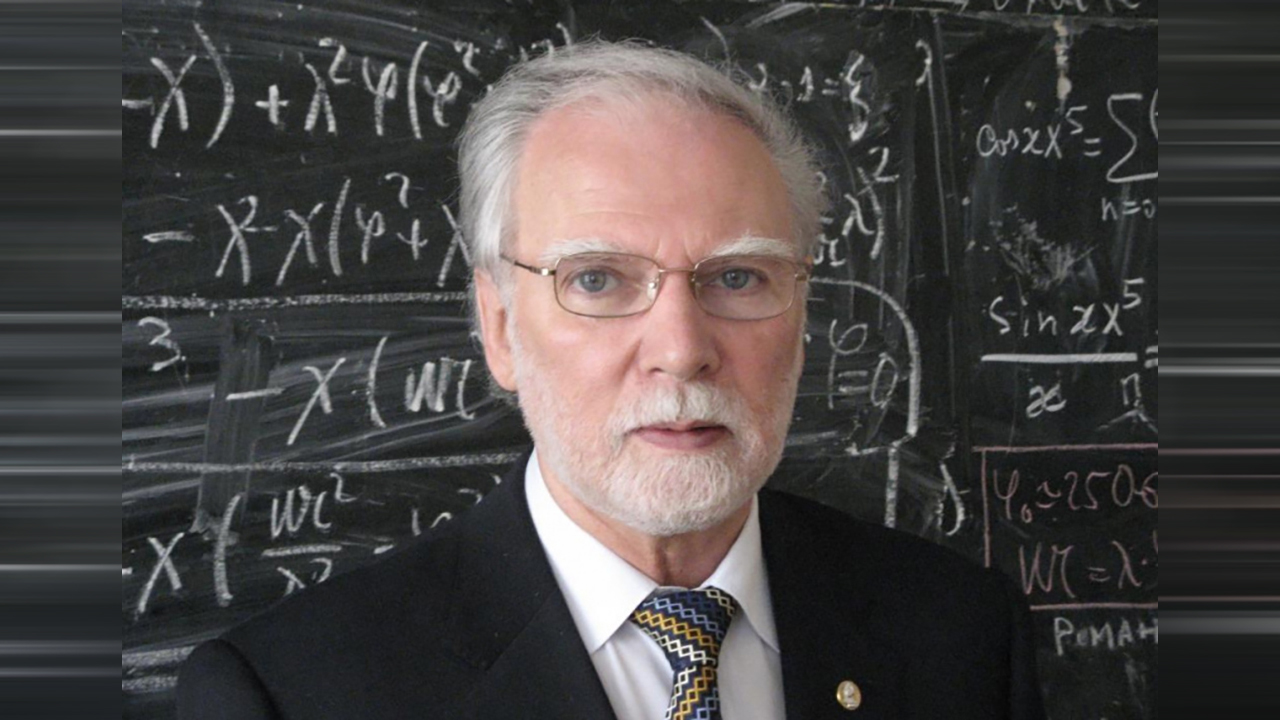To 85th anniversary of Vladimir Georgievich Kadyshevsky
News, 05 May 2022
5 May, 2022 marks the 85th anniversary of the birth of a special person, an outstanding theoretical physicist and science organizer, the Director of the Joint Institute for Nuclear Research (1992-2005), Academician of the Russian Academy of Sciences Vladimir Georgievich Kadyshevsky.
Vladimir Georgievich was born on 5 May, 1937 in Losinoostrovsk, a suburb of Moscow. He was the second child in the family of cartographers Georgy Fedorovich Kadyshevsky and Rufina Mikhailovna Kadyshevskaya. When the Great Patriotic War began, Volodya’s father went to the front with the first wave of the Moscow militia and went missing near Vyazma in November 1941. Vladimir Georgievich retained in his memory only a few episodes of contact with his father, but he always remembered him with the same tenderness.
Since that time, little Volodya became fatherless and after the appearance of his stepfather in their family, he often ran away from home. During one of these escapes, Volodya made his way to the Victory Parade on Red Square on 24 June, 1945. Rufina Mikhailovna realized that she herself could not manage with parenting her son and sent Volodya to study at the Suvorov Military School, which was first located in the city of Yelets and later moved to Sverdlovsk (now Yekaterinburg).
Studying at the Suvorov School really was a salvation for Volodya and to a large extent determined the qualities of his character and the attitude towards life. As Vladimir Georgievich said, if it were not for Suvorov’s “cadet” education, nobody knew which path he would have taken… It was there that he was instilled with a desire to be the first in everything and did his best to achieve his goals. The Suvorov School became an excellent school of life for Vladimir Georgievich. The habit of significant workloads and regime were useful to him in the future more than once. Having kept warm memories of the Suvorov Military School, Vladimir Georgievich at various times came to meetings of former cadets and his portrait holds a worthy place in the gallery of famous graduates, although it looks unusual among the military, mostly with high ranks.
While studying at the School, Vladimir Georgievich’s talent for science and his thirst for knowledge manifested themselves. The break news on the launch of the world’s first nuclear power station in the USSR in 1954 had a significant impact on the choice of his further scientific path. This event made Vladimir Georgievich to get interested in nuclear physics. The preparation at the School was carried out at a fairly good level, which together with Volodya’s abilities allowed him to later graduate from the School with a Gold Medal and quite easily pass the entrance exams to Moscow State University. However, achieving his goal – to study at Moscow State University, turned out to be not an easy task. Formally, graduates of the School were “automatically” distributed to military educational institutions, and Vladimir Georgievich was assigned to the Infantry School, located in the same building as Suvorov School. And only with the help of caring teachers and friends, by hook or by crook, Vladimir Georgievich managed to get his documents and leave to enter Moscow University.
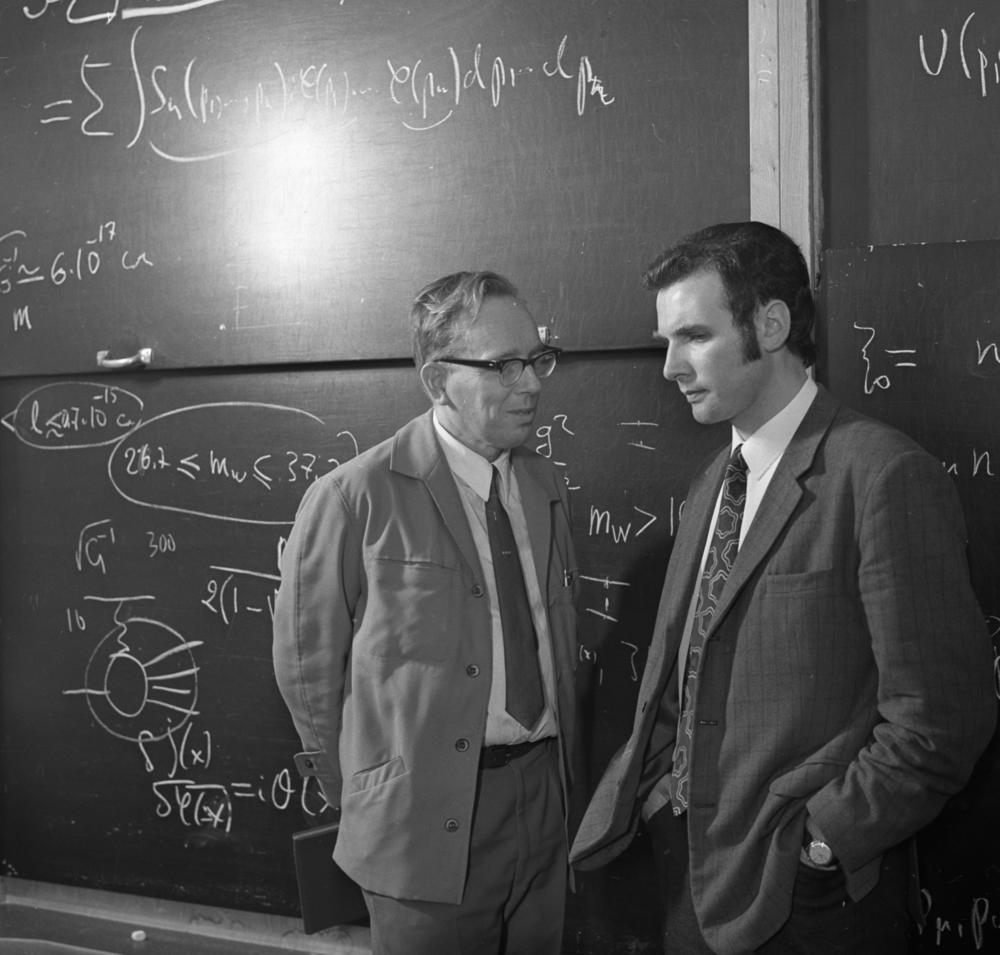 D. V. Shirkov and V. G. Kadyshevsky, 1974
D. V. Shirkov and V. G. Kadyshevsky, 1974
The interests of Vladimir Georgievich were not limited to the exact sciences. Since childhood, he had read a lot and thanks to his teacher of Literature, who he thought with gratitude about, he grew up as a man with an unusually fine sense of the Russian language, “absolutely literate.” He could quote all possible grammatical rules with pleasure, knew a large number of poems by heart and was fond of collecting catchphrases and sayings. According to the stories of his colleagues and employees, as a Head, Vladimir Georgievich was very demanding on the competent execution of all documents: orders, presentations, reports, letters, sometimes returning such documents several times for revision. At the same time, he was just as demanding of himself. Being an extremely intelligent person, he always expressed his opinion and made his remarks in an extremely gentle and respectful manner and his impeccable Russian language was always expressive and precise.
The main hobby, not related to science, for Vladimir Georgievich was music. In the Suvorov School, in addition to the usual subjects, students were taught playing musical instruments, fencing, ballroom dancing and horse riding. And if learning to dance was difficult for Volodya, then in music he turned out to be gifted almost as much as in science. Vladimir Georgievich had an absolute ear for music. At the School, he learned to play the violin, mandolin and banjo. Later, as a student, he took a mandolin with him when he went to the Virgin Lands campaign in South Kazakhstan or on other trips. Love for music, mainly classical, Vladimir Georgievich carried through his whole life. He understood music professionally and knew its history and at home he often turned on television broadcasts of classical music concerts. It happened that he offered his conversation partners to guess the piece of music that sounded at the moment somewhere on the radio or TV. Vladimir Georgievich was closely acquainted with many musicians and even sometimes arranged impromptu home concerts, where he also played an instrument. He often attended concerts in famous Moscow halls and practically did not miss such concerts in Dubna. It was probably predetermined that the wonderful Russian composer Alexey Rybnikov, whose music is known all over the world, became the brother-in-law of Vladimir Georgievich. Vladimir Georgievich enjoyed fellowship with him and of course he knew and loved his music.
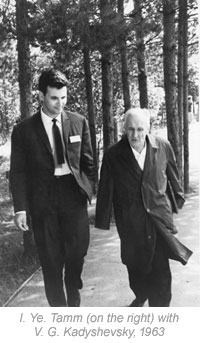 The main hobby of Vladimir Georgievich – his passion for theoretical physics manifested itself already in the first years of the university. In the 3rd year, he began to pass Landau’s theoretical minimum. Once, in his 4th year, Vladimir Georgievich happened to be at a meeting of Moscow State University students with Igor Evgenievich Tamm. The auditorium was filled to capacity. Vladimir Georgievich wanted to ask Tamm about the “new uncertainty correlation”, but did not dare to do this, since the question required a mathematical introduction that most likely would not be of interest to the audience. However, he asked the organizers to tell Igor Evgenievich that he wanted to talk to him about physics. Upon learning this, Tamm offered Vladimir Georgievich to take a taxi in his company and then they discussed the issue for another half an hour walking around evening Moscow. It turned out that a contact with any person in such a democratic manner was regular for Tamm. In 1959, V.G.Kadyshevsky defended his diploma thesis “On Mass Spectrum and Fundamental Length in Field Theory” that was close in subject matter to the interests of I.E.Tamm. This research paper won the First Prize and was awarded the Medal of the Ministry of Higher and Secondary Special Education of the USSR in the All-Union competition of students’ theses. After graduating from the university in 1960, he was left at Graduate School at the department of N. N. Bogoliubov. In 1962, V.G.Kadyshevsky successfully defended his Ph.D. thesis and started his work at the Laboratory of Theoretical Physics of JINR.
The main hobby of Vladimir Georgievich – his passion for theoretical physics manifested itself already in the first years of the university. In the 3rd year, he began to pass Landau’s theoretical minimum. Once, in his 4th year, Vladimir Georgievich happened to be at a meeting of Moscow State University students with Igor Evgenievich Tamm. The auditorium was filled to capacity. Vladimir Georgievich wanted to ask Tamm about the “new uncertainty correlation”, but did not dare to do this, since the question required a mathematical introduction that most likely would not be of interest to the audience. However, he asked the organizers to tell Igor Evgenievich that he wanted to talk to him about physics. Upon learning this, Tamm offered Vladimir Georgievich to take a taxi in his company and then they discussed the issue for another half an hour walking around evening Moscow. It turned out that a contact with any person in such a democratic manner was regular for Tamm. In 1959, V.G.Kadyshevsky defended his diploma thesis “On Mass Spectrum and Fundamental Length in Field Theory” that was close in subject matter to the interests of I.E.Tamm. This research paper won the First Prize and was awarded the Medal of the Ministry of Higher and Secondary Special Education of the USSR in the All-Union competition of students’ theses. After graduating from the university in 1960, he was left at Graduate School at the department of N. N. Bogoliubov. In 1962, V.G.Kadyshevsky successfully defended his Ph.D. thesis and started his work at the Laboratory of Theoretical Physics of JINR.
Vladimir Georgievich considered I. E. Tamm and N. N. Bogoliubov his main teachers in science. While studying at Graduate School, he attended the seminar of I.E.Tamm on Tuesdays and once he himself gave a report on the development of Snyder’s theory. At the end of the seminar, Tamm spoke approvingly about the report and in his democratic manner offered to jointly research this topic with the phrase: “May I work with you?” Later, I.E.Tamm was appointed as an opponent at the defense of Vladimir Georgievich’s doctoral dissertation. His arrival at BLTP JINR and speaking as an opponent became significant events in the life of the Laboratory.
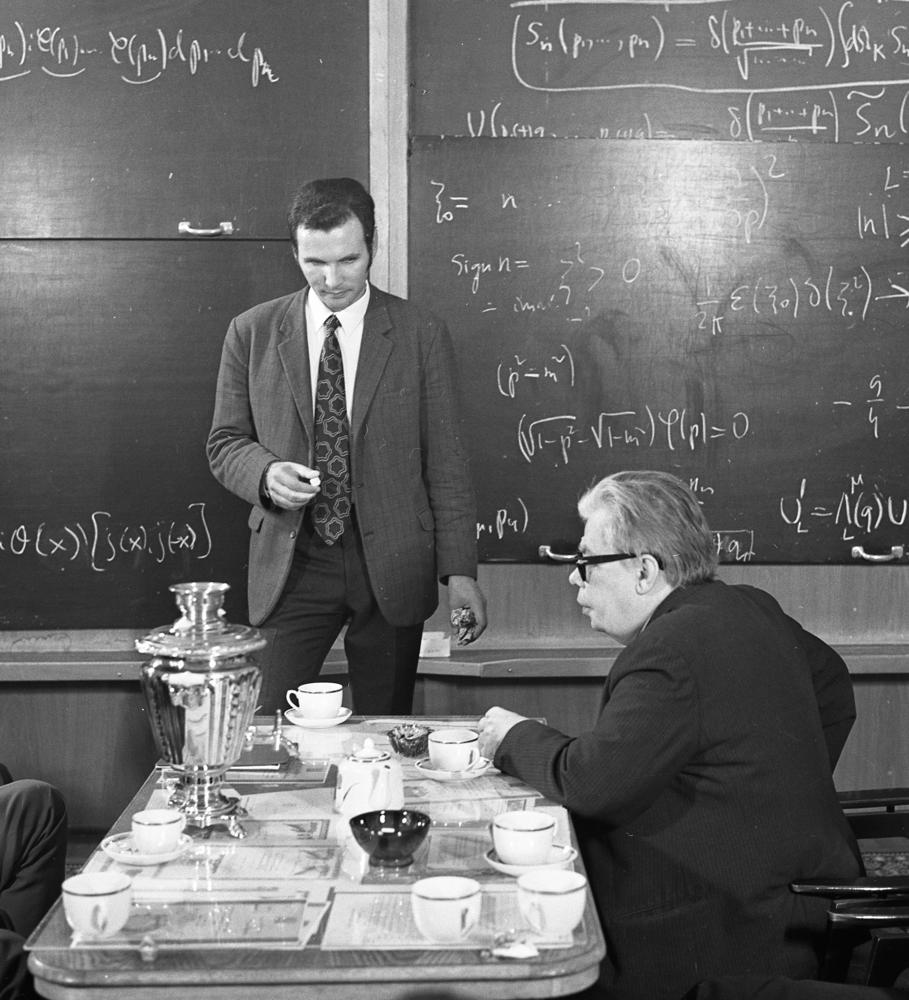 In the photo: V. G. Kadyshevsky and N. N. Bogoliubov, 1964
In the photo: V. G. Kadyshevsky and N. N. Bogoliubov, 1964
During his studies at Moscow State University, Vladimir Georgievich met his future wife, Lina Ivanovna Kurakova. She played the piano beautifully and Vladimir Georgievich began to participate in amateur performances in order to play a duet with her. In January, 1958 they got married. Lina Ivanovna’s family accepted Vladimir Georgievich very warmly. We can say that from his wife, her mother and grandmother he got the love and care that he lacked in childhood.
In 1964, Vladimir and Lina had a daughter, Tatyana. The first years, Tanya lived in Simferopol with her grandmothers and her parents came to her once a month and on holidays. In 1968, grandmothers with Tanya moved to the Moscow region. Lina Ivanovna worked at Moscow State University and Vladimir Georgievich – at JINR, so for many years they lived “in two cities”, but whenever possible, Lina Ivanovna came to Dubna or Vladimir Georgievich came to Moscow, since the work of physicist-theoretician allowed him to be not tied to the Laboratory and he was able to spend part of the working week with his wife.
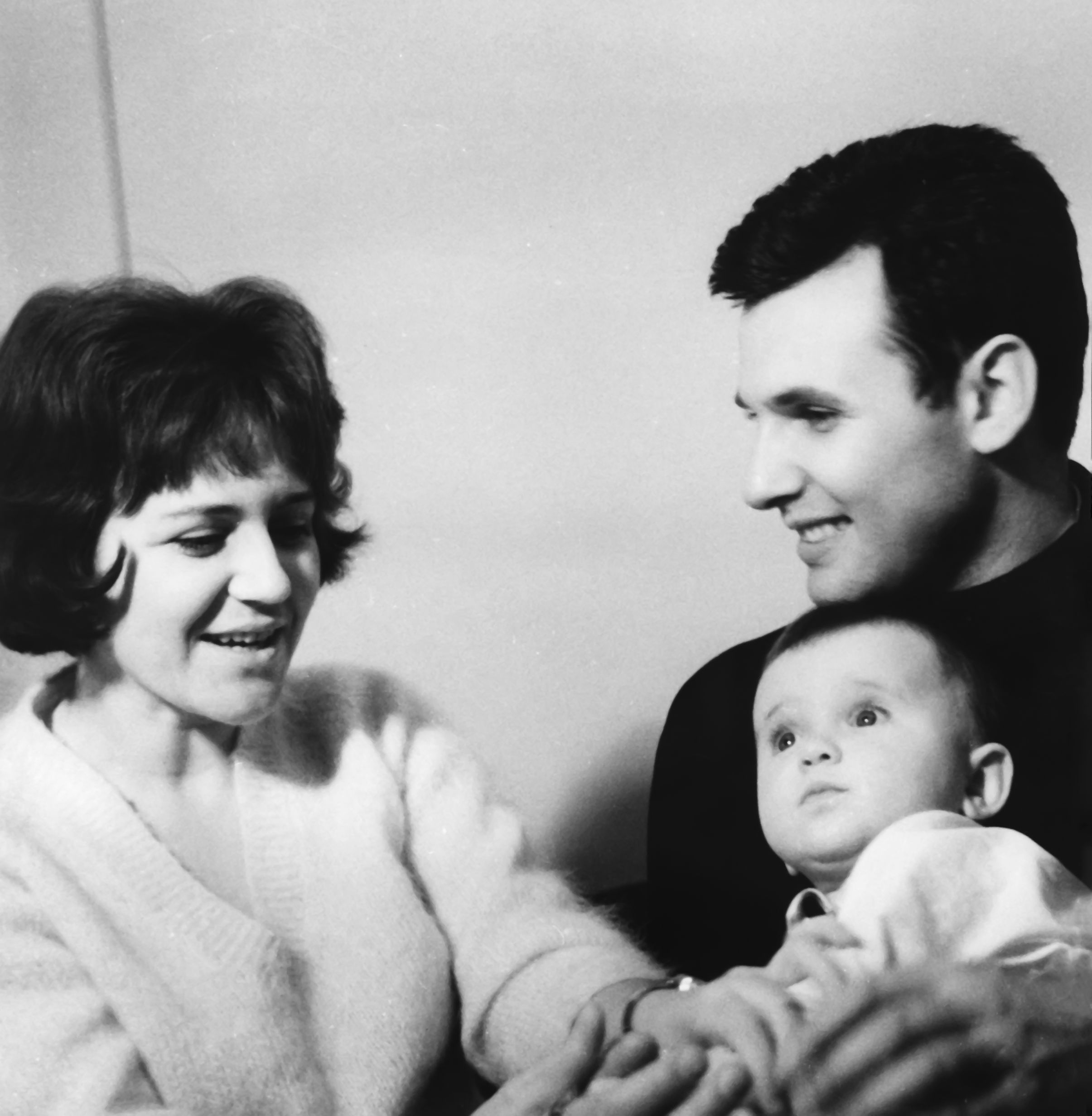 V. G. Kadyshevsky with his wife and daughter, 1964
V. G. Kadyshevsky with his wife and daughter, 1964
In his scientific work, Vladimir Georgievich achieved outstanding results in research on the elementary particle theory and high energy physics. His name is associated with the relativistic formulation of the quantum field theory in the quantum spacetime satisfying the unitarity requirements and the generalised causality condition. Vladimir Georgievich’s work in this area having won worldwide recognition forereached the research on “non-commutative geometry” in the 1990s. In the theory of internal unitary symmetry, Vladimir Georgievich established a range of correlations for efficient cross sections, masses and magnetic moments of hadrons that were experimentally confirmed. Even before the Standard Model of electroweak interactions was developed, he had studied lepton-hadron symmetries that are revealed in weak processes with the exchange of intermediate vector bosons.
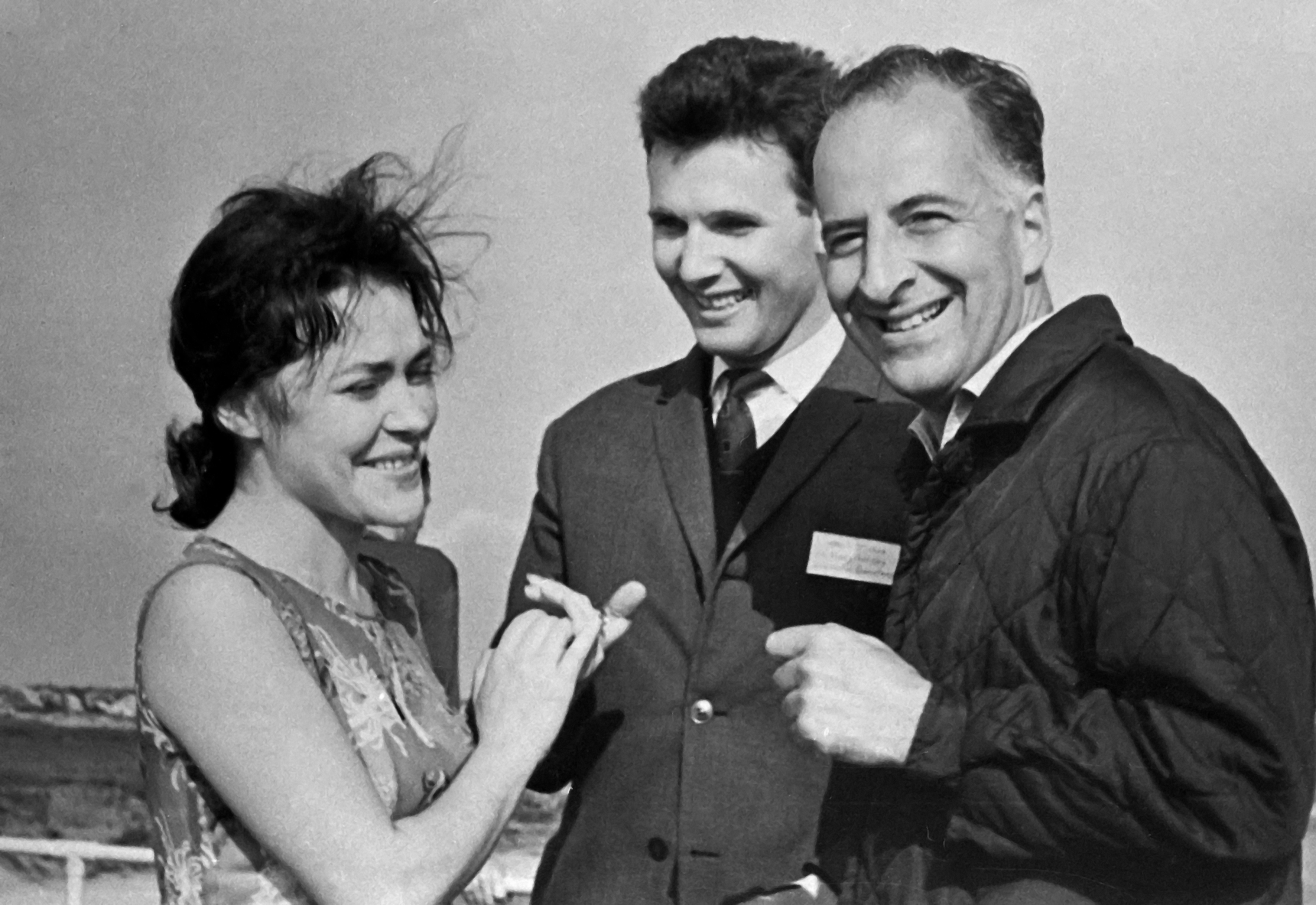 From left to right: Nadezhda Isaeva, Vladimir Kadyshevsky, Bruno Pontecorvo, 1964
From left to right: Nadezhda Isaeva, Vladimir Kadyshevsky, Bruno Pontecorvo, 1964
Since 1964, Vladimir Georgievich had published a cycle of papers dedicated to the covariant Hamiltonian formulation of the quantum field theory. He worked out a unique diagram technique that, unlike the well-known Feynman technique, operates at amplitudes on mass surface. The application of this apparatus to the task of the interaction of two relativistic particles allowed to reduce the number of variables and establish a 3D integral equation for the relativistic scattering amplitude, today known in references as the Kadyshevsky equation. The approach of Vladimir Georgievich, being theoretically consistent, allows one to transfer research techniques, as well as intuition and experience accumulated in the theory of similar nonrelativistic systems, such as low-nucleon atomic nuclei, to the area of elementary particle physics. The Kadyshevsky equation has gained worldwide fame and is applied by physicists from different countries for practical calculations of hadron-hadron and hadron-nucleus interactions, as well as for describing the quark structure of hadrons.
Considering the relativistic nature of the task, instead of the Fourier transform, Vladimir Georgievich applied, in the developed formalism, an expansion in terms of the basis in the space of a unitary representation of the Lorentz group. As a result, it was possible to introduce the 3D relativistic position operator and the corresponding relativistic configuration representation into the theory. In the new configuration representation, the Kadyshevsky equation turned out to be a finite-difference equation with a step equal to the Compton wavelength of a particle. Investigating specific physical applications of his equation, Vladimir Georgievich simultaneously developed efficient methods for solving difference equations.
Vladimir Georgievich proposed a fundamentally new geometric approach to describing electroweak interactions outside the Standard Model. This approach was based on the field theory formulated in five-dimensional momentum space with buckling constant. Within this approach, a range of experimental predictions have been made.
It should be noted that Vladimir Georgievich defended his doctoral dissertation in 1968, that is, at the age of 31 and in 1970 he became a professor at the Department of Quantum Statistics and Field Theory of the Faculty of Physics of Moscow State University, headed by N. N. Bogoliubov. Following the example of his teachers, Vladimir Georgievich devoted a lot of time to teaching and communicating with scientific youth. He conducted and organized numerous youth scientific schools, taught students to think outside the box and in an original way, he knew how to amaze with the depth of his knowledge and infect with a craving for learning new things. He treated the youth carefully, but demandingly, he liked to repeat the phrase, “Hurry up to make scientific discoveries, science is driven by the efforts of the youth.” Vladimir Georgievich tried to support namely active and talented students, appreciated the desire for the highest scientific goals.
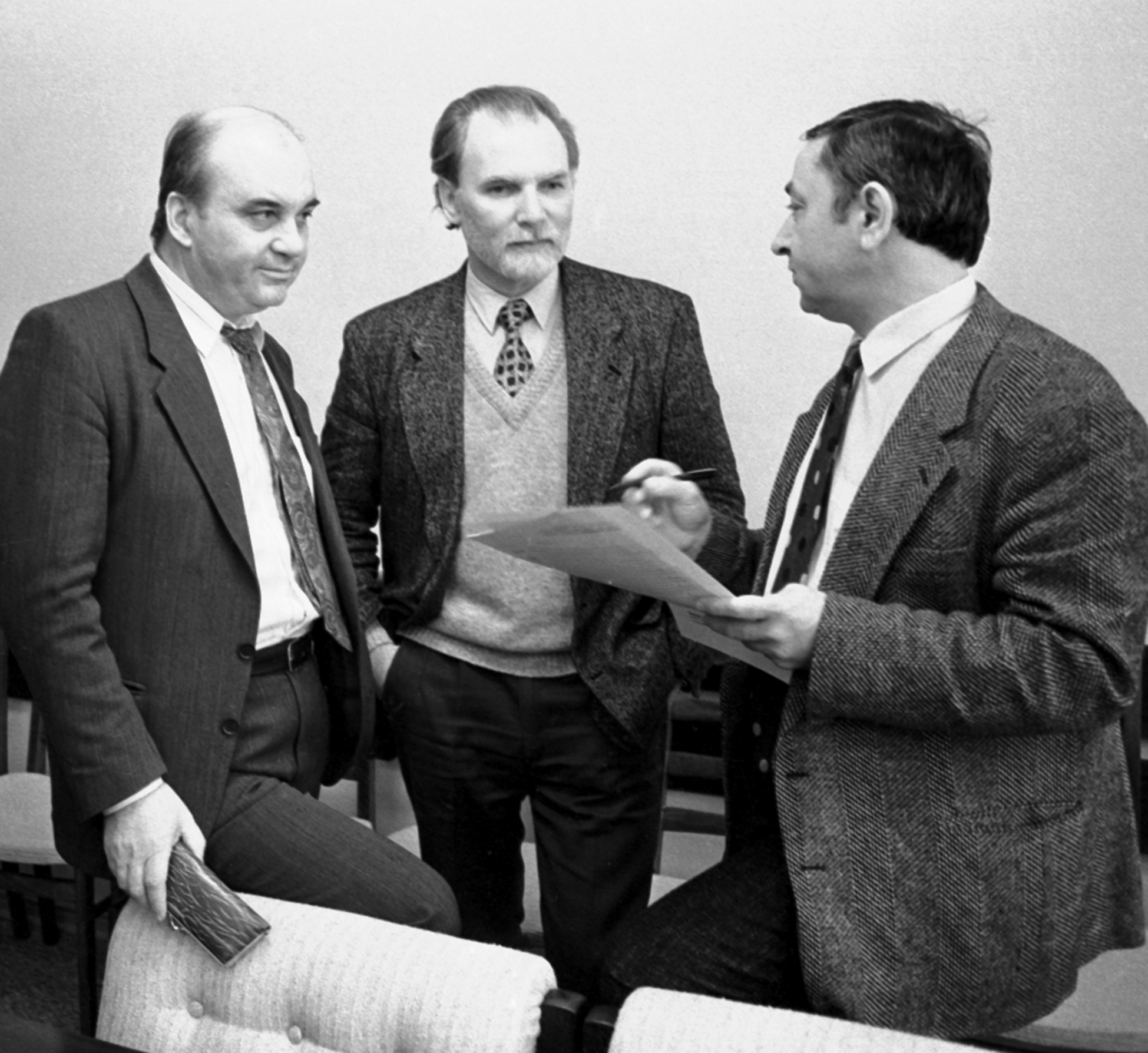 From left to right: Ts. D. Vylov, V. G. Kadyshevsky, A. N. Sissakian, 1992
From left to right: Ts. D. Vylov, V. G. Kadyshevsky, A. N. Sissakian, 1992
In 2003, V.G.Kadyshevsky was appointed Head of the Department of Elementary Particle Physics (Faculty of Physics, Moscow State University). More than 15 Ph.D. theses were defended under his supervision. Many of his students have become well-known scientists and successfully work in Russian and foreign scientific centers.
It is worth mentioning the outstanding scientific and organizational work of Vladimir Georgievich. In 1977-1978 he headed a group of Soviet physicists who worked at the Fermi National Accelerator Laboratory (FNAL) in the USA. In 1983-1985, Vladimir Georgievich was the leader of activities in the DELPHI programme (JINR) on experiments at the LEP electron-positron collider at CERN. It was a massive advanced experiment. Theoretical research in this programme was carried out under his leadership. The emphasis on the scientific component of the project allowed JINR scientists to make a serious contribution to world-class physics and it was Vladimir Georgievich who played a crucial role in this. He himself and his proposals were always carefully listened to and treated with deep respect.
In 1987, Vladimir Georgievich was elected Director of the Laboratory of Theoretical Physics of JINR, succeeding Nikolay Nikolaevich Bogoliubov. He carried out a reform of the organizational structure, abolishing departments that contributed to the unity of the Laboratory and the development of active interdisciplinary interaction within BLTP. He made an important contribution to the promotion of high scientific traditions of the Dubna School of theoreticians, as well as to the development of broad international cooperation and the actualisation of ongoing research.
In 1992, Vladimir Georgievich was elected Director of JINR, the largest international scientific center and worked in this position until 2005. These were the most difficult years for the country, science and the Institute. The financial problems of the Institute were colossal, seemingly insoluble: salary payments were delayed for several months, there was a large debt for electricity and the contributions of the Member States to the JINR budget were not paid in full. There were practically no resources left to finance the pilot program. Vladimir Georgievich and his team played a decisive role in the promotion of the international status and survival of the Institute. In those difficult years, the JINR Directorate managed not only to maintain the Institute, but also considerably enhanced its positions.
One of the innovative decisions taken on the initiative of Vladimir Georgievich was the nomination of JINR together with CERN for the Nobel Peace Prize. Efforts were dedicated to get support for this nomination from famous people in the world. And although the result was not achieved, this nomination allowed JINR to be familiar to everybody that often became a decisive argument and generally supported the value of scientific knowledge and the significance of funding science in a difficult economic period.
Vladimir Georgievich on many occasions met with members of the government, deputies of the State Duma and everyone who the receipt of funds and support for the Institute depended on. And the wide range of acquaintances of Vladimir Georgievich, as well as his extraordinary ability to explain complex things in simple terms, to find the right words and interest the conversation partners, also played an essential role.
Despite the difficult economic situation, a delicate balance was struck between the costs of the Institute’s staff and its experimental program. Thus, without losing staff, it was possible to preserve and expand the JINR research program to the maximum. During this period, such significant results were achieved, as the early experiments at the first in Russia superconducting accelerator of relativistic nuclei – the Nuclotron; modernisation of the IBR-2 research reactor, the neutron beams of which possess record parameters. For the first time in the world, the synthesis of new superheavy elements was carried out at the U-400 cyclotron and research programs in elementary particle physics were developed at the facilities of JINR and other major scientific centers of the world.
Another essential area in the work of V. G. Kadyshevsky as Director of JINR was the preservation and expansion of international cooperation. Vladimir Georgievich sought to convince the PRC Leadership of the urgency and significance for China to become a JINR Member State again. There were also negotiations on India to become a Member State of JINR. Despite the fact that these plans have not yet been realized, thanks to the performed work, not only individual scientific contacts between scientists have been established, but also relationships with scientific organizations in these countries. At the same time, many cooperation agreements were signed with other non JINR Member State countries. It was then today’s JINR slogan “Science brings nations together” came forth.
All this was not easy, sometimes Vladimir Georgievich and other employees of Directorate stayed up late at work, sometimes after midnight. But the result, including the current status and development of the Institute, is largely the prize of those years to sustain the efficiency of JINR, its development with a focus on traditions and the preservation of its international status. By the end of the authority of Vladimir Georgievich as Director in 2005 the Institute was in stable state and its scientific program was actively developing. Partly for the sake of the future of the Institute, Vladimir Georgievich had to sacrifice his labor of love – being engaged in science that, according to the testimony of those around him, greatly upset him.
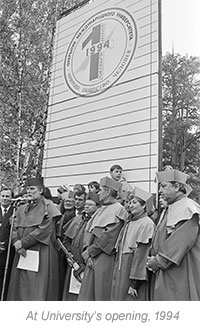 One of the most remarkable creations of Vladimir Georgievich was the International University of Nature, Society and Man, opened in Dubna on his initiative in 1994. A year after the founding of the university, V.G.Kadyshevsky became its President. Participating in the elections of JINR Director, Vladimir Georgievich emphasized as a separate item of his program the importance to develop an international educational institution at the international scientific center that was JINR. Currently, the university actively develops and has become an educational institution of federal significance. It is no coincidence that the recently opened school lyceum in Dubna with in-depth study of mathematics and physics is named after V. G. Kadyshevsky.
One of the most remarkable creations of Vladimir Georgievich was the International University of Nature, Society and Man, opened in Dubna on his initiative in 1994. A year after the founding of the university, V.G.Kadyshevsky became its President. Participating in the elections of JINR Director, Vladimir Georgievich emphasized as a separate item of his program the importance to develop an international educational institution at the international scientific center that was JINR. Currently, the university actively develops and has become an educational institution of federal significance. It is no coincidence that the recently opened school lyceum in Dubna with in-depth study of mathematics and physics is named after V. G. Kadyshevsky.
As a citizen of Dubna and Head of the largest city organization, Vladimir Georgievich took an active part in solving city issues, as well as in determining the city’s development strategy. One of the key achievements in this area was the awarding of the status of a Science City to Dubna, as well as the organization of a Special Economic Zone in Dubna, the idea of which Vladimir Georgievich considered useful and strongly supported.
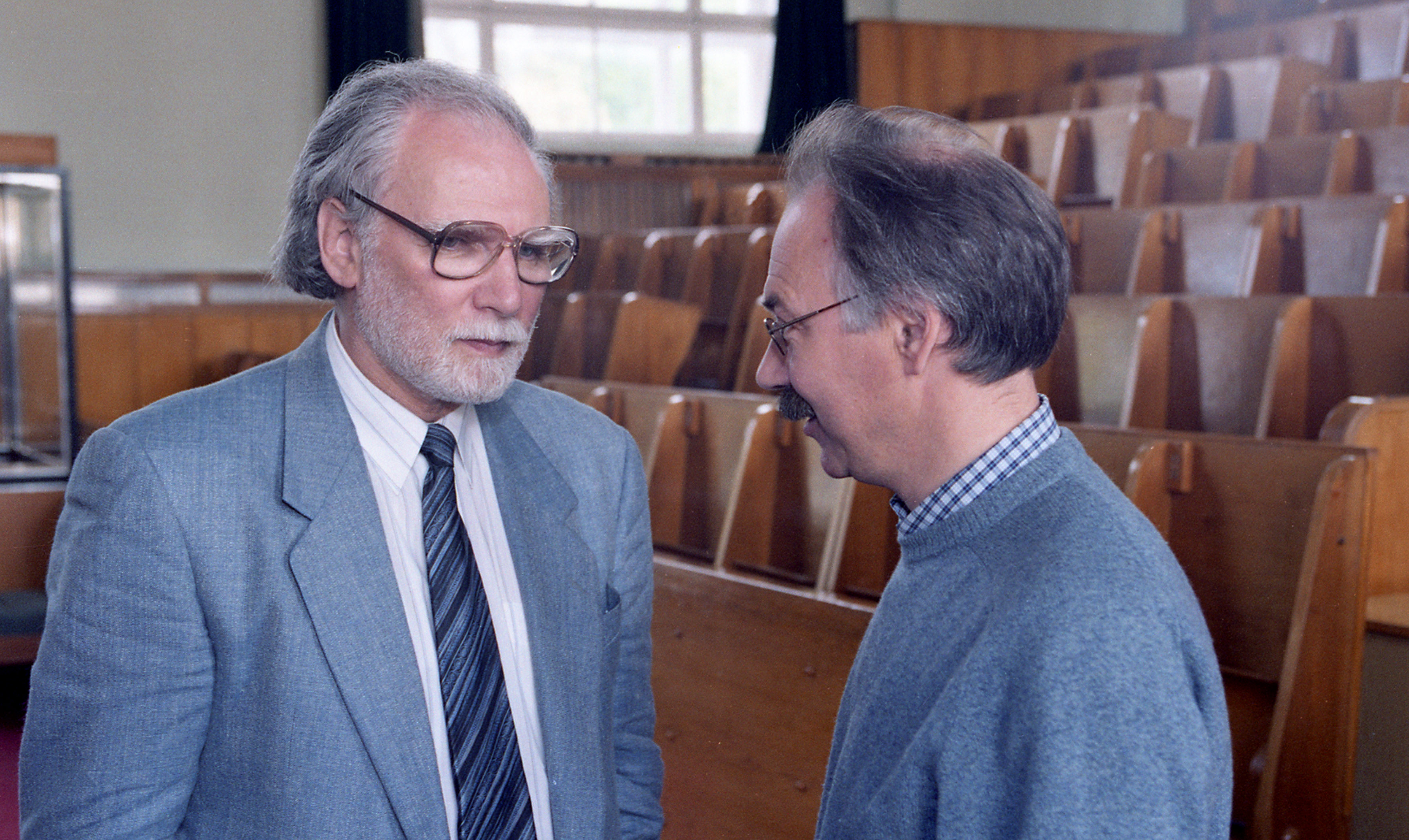 V. G. Kadyshevsky and D. I. Kazakov, 2001
V. G. Kadyshevsky and D. I. Kazakov, 2001
It is difficult to list all the unions, presidiums and councils in which V.G.Kadyshevsky took part. He was Member of the Presidium of the Russian Academy of Sciences, Member of the Expert Advisory Board under the Chairman of the Accounts Chamber of the Russian Federation. Over the years he was President of the Union of Scientific Societies of Russia, Member of the IUPAP Commission on Particles and Fields, Member of the Commission under RF President on awarding State Prizes of the Russian Federation in the field of science and technology.
The scientific achievements of Vladimir Georgievich were awarded the N. M. Krylov Prize (1990) and the N. N. Bogoliubov Prize (2001) of the National Academy of Sciences of Ukraine, the N. N. Bogoliubov Prize (JINR, 2006). He was the Honorary Doctor of several foreign universities, Honorary or Foreign Member of a number of Academies.
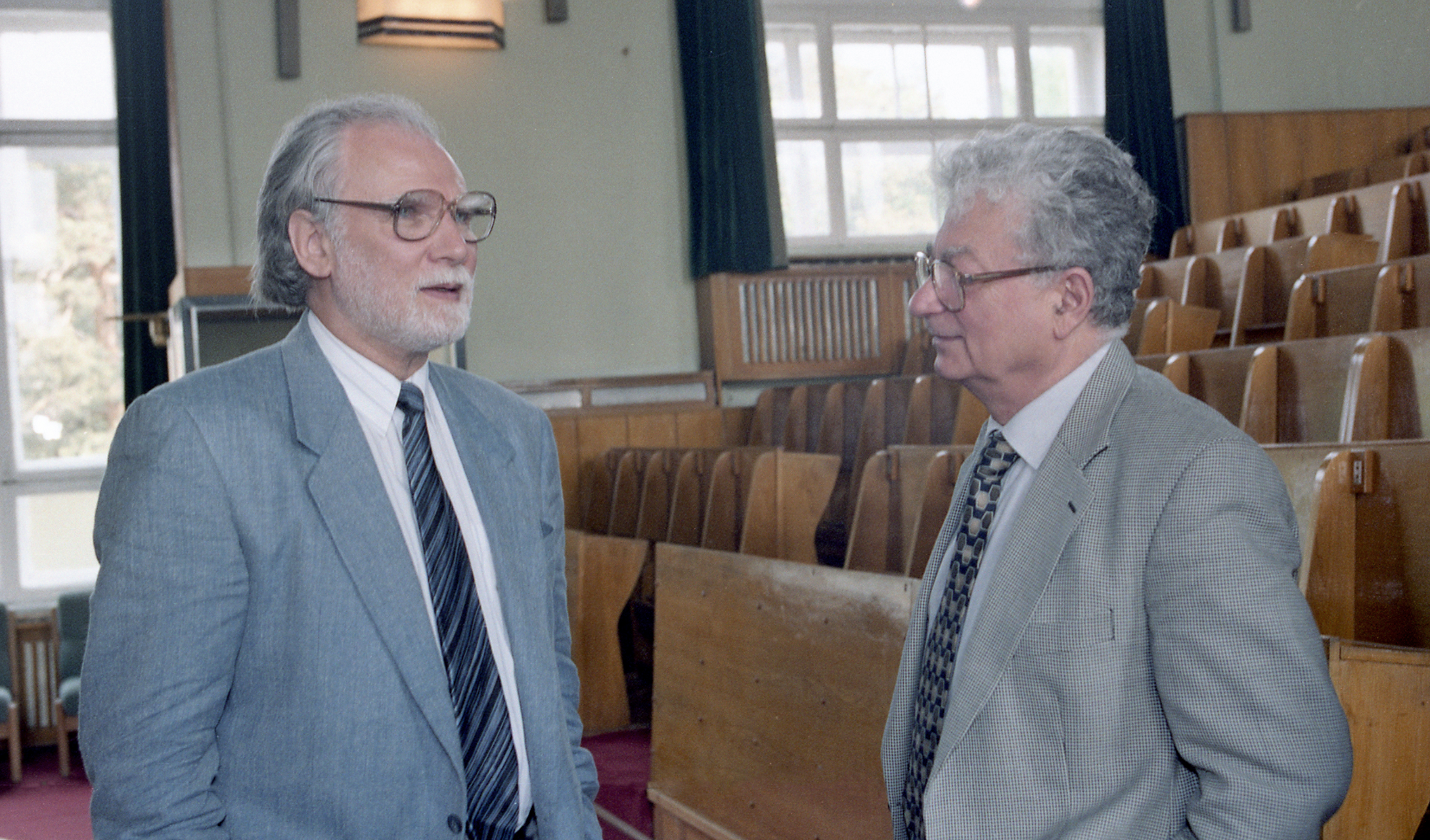 V. G. Kadyshevsky and Yu. Ts. Oganessian, 2001
V. G. Kadyshevsky and Yu. Ts. Oganessian, 2001
Vladimir Georgievich, honorary citizen of the city of Dubna and the Moscow region, is holder of the Order of Friendship of Peoples, the Order of Honor for “Services to the Fatherland” IV degree, as well as Foreign Orders and Medals, was awarded the Gold Medal of the International Association of Academies of Sciences “For the Promotion of Science” (2002) and the Gold Medal “For the Activities for the Benefit of Society” (the Institute of European Integration, 2003).
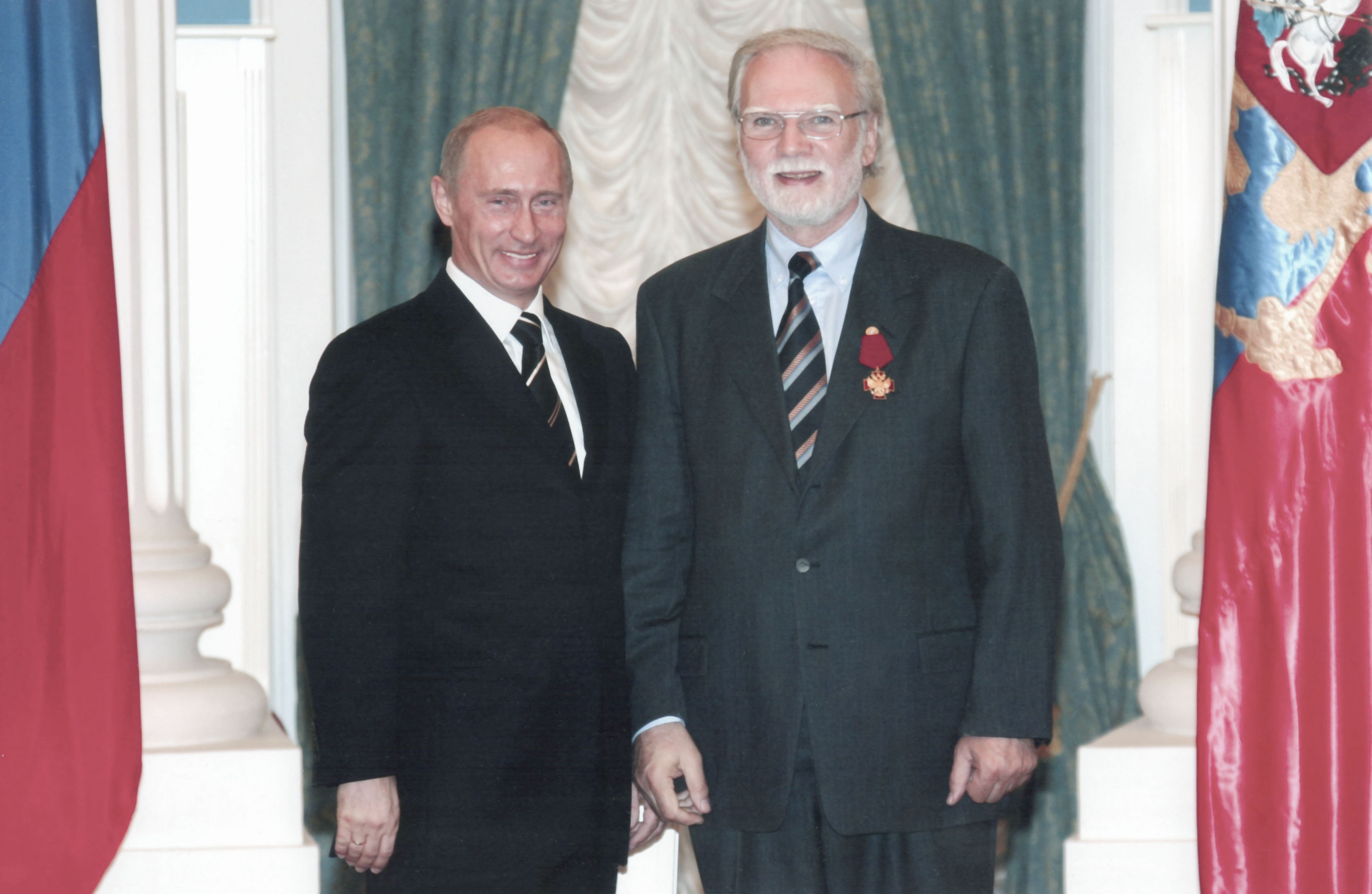 V. V. Putin and V. G. Kadyshevsky, 2006
V. V. Putin and V. G. Kadyshevsky, 2006
Despite his high position, Vladimir Georgievich always remained a modest person, rather unpretentious in everyday life. The decor in his house was quite simple and repairs could not be done for many years. The material side was not important to him at all.
Vladimir Georgievich was a bright personality, a man of many talents, a simple and cultured person, an intellectual in the highest degree. A talented physicist and organizer, he set an example of devotion to science, efficiency, purposefulness and exactingness to himself. He was an extremely versatile, attentive and interesting conversationalist and his charm invariably fascinated. Always confident and friendly, moderately strict, but ready to accept a different point of view, he set an example of a real scientist and a leader. He loved life and valued people, was a devoted friend, a loving husband and father.
The material was prepared based on biographical data, memoirs of colleagues, friends, and relatives of V. G. Kadyshevsky.
